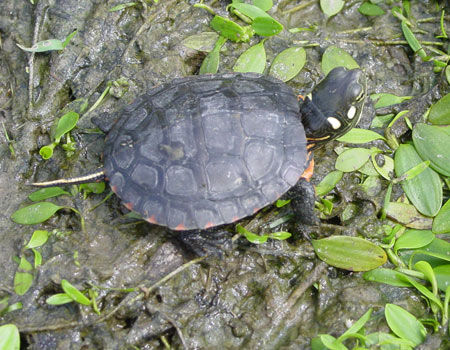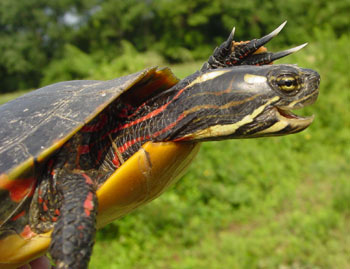Field Guide to Maryland's Turtles (Order Testudines)
Main_Content
Eastern Painted Turtle (Chrysemys p. picta) | | Common Name:
|

Photo of Eastern Painted Turtle courtesy of Corey Wickliffe |
Size: 4½ - 6 inches. Record - 7 inches |
Appearance:The Midland Painted and the Eastern Painted are two subspecies of Painted Turtle. They share a similar appearance.
- The smooth and flattened carapace is olive to black with a border of red crescents or bars.
- The large scutes of the carapace are in nearly straight rows, with the light olive bands crossing the back and are good diagnostic features.
- Two bright yellow spots are on either side of the head, which also has yellow stripes through the eyes and along the jawline.
- The upper jaw has a central notch bordered by two tooth-like cusps (but see Red-bellied Turtle).

Photo of Eastern Painted Turtle courtesy of Corey Wickliffe
|
Habitats:Slow-moving shallow water habitats with muddy bottoms and aquatic vegetation, including ponds, marshes, lakes, river pools and ditches. It can be found in both fresh and brackish water.
|
How to Find:The most conspicuous basking turtle we have, they can be active in any month, but typically observed basking April to September. Observe them through binoculars on fallen logs and debris along shorelines, typically in early morning, midday and early afternoon. Also, find them on land nesting in loose soil from late May to early July.
|
Distribution in Maryland:Painted turtles are found throughout Maryland. Eastern Painted Turtles will be found in the southern and eastern counties and may breed with Midland Painteds where they overlap in Central Maryland.

|
|
